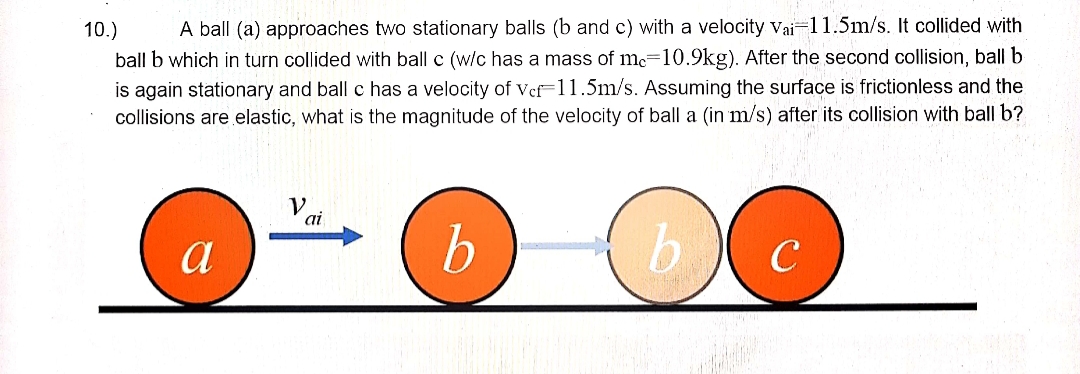A ball (a) approaches two stationary balls (b and c) with a velocity vai=11.5m/s. It collided with ball b which in turn collided with ball c (w/c has a mass of mc=10.9kg). After the second collision, ball b is again stationary and ball c has a velocity of vcf=11.5m/s. Assuming the surface is frictionless and the collisions are elastic, what is the magnitude of the velocity of ball a (in m/s) after its collision with ball b?
A ball (a) approaches two stationary balls (b and c) with a velocity vai=11.5m/s. It collided with ball b which in turn collided with ball c (w/c has a mass of mc=10.9kg). After the second collision, ball b is again stationary and ball c has a velocity of vcf=11.5m/s. Assuming the surface is frictionless and the collisions are elastic, what is the magnitude of the velocity of ball a (in m/s) after its collision with ball b?
College Physics
11th Edition
ISBN:9781305952300
Author:Raymond A. Serway, Chris Vuille
Publisher:Raymond A. Serway, Chris Vuille
Chapter6: Momentum, Impulse, And Collisions
Section: Chapter Questions
Problem 53P: A billiard ball moving at 5.00 m/s strikes a stationary ball of the same mass. Alter the collision,...
Related questions
Question
A ball (a) approaches two stationary balls (b and c) with a velocity vai=11.5m/s. It collided with ball b which in turn collided with ball c (w/c has a mass of mc=10.9kg). After the second collision, ball b is again stationary and ball c has a velocity of vcf=11.5m/s. Assuming the surface is frictionless and the collisions are elastic, what is the magnitude of the velocity of ball a (in m/s) after its collision with ball b?
Give the formula first then solve.

Transcribed Image Text:A ball (a) approaches two stationary balls (b and c) with a velocity vai-11.5m/s. It collided with
ball b which in turn collided with ball c (w/c has a mass of mc=10.9kg). After the second collision, ball b
is again stationary and ball c has a velocity of Vef-11.5m/s. Assuming the surface is frictionless and the
collisions are elastic, what is the magnitude of the velocity of ball a (in m/s) after its collision with ball b?
10.)
ai
a
b.
b.
Expert Solution
This question has been solved!
Explore an expertly crafted, step-by-step solution for a thorough understanding of key concepts.
This is a popular solution!
Trending now
This is a popular solution!
Step by step
Solved in 3 steps

Knowledge Booster
Learn more about
Need a deep-dive on the concept behind this application? Look no further. Learn more about this topic, physics and related others by exploring similar questions and additional content below.Recommended textbooks for you

College Physics
Physics
ISBN:
9781305952300
Author:
Raymond A. Serway, Chris Vuille
Publisher:
Cengage Learning

Physics for Scientists and Engineers: Foundations…
Physics
ISBN:
9781133939146
Author:
Katz, Debora M.
Publisher:
Cengage Learning

College Physics
Physics
ISBN:
9781285737027
Author:
Raymond A. Serway, Chris Vuille
Publisher:
Cengage Learning

College Physics
Physics
ISBN:
9781305952300
Author:
Raymond A. Serway, Chris Vuille
Publisher:
Cengage Learning

Physics for Scientists and Engineers: Foundations…
Physics
ISBN:
9781133939146
Author:
Katz, Debora M.
Publisher:
Cengage Learning

College Physics
Physics
ISBN:
9781285737027
Author:
Raymond A. Serway, Chris Vuille
Publisher:
Cengage Learning

Classical Dynamics of Particles and Systems
Physics
ISBN:
9780534408961
Author:
Stephen T. Thornton, Jerry B. Marion
Publisher:
Cengage Learning

Principles of Physics: A Calculus-Based Text
Physics
ISBN:
9781133104261
Author:
Raymond A. Serway, John W. Jewett
Publisher:
Cengage Learning

University Physics Volume 1
Physics
ISBN:
9781938168277
Author:
William Moebs, Samuel J. Ling, Jeff Sanny
Publisher:
OpenStax - Rice University